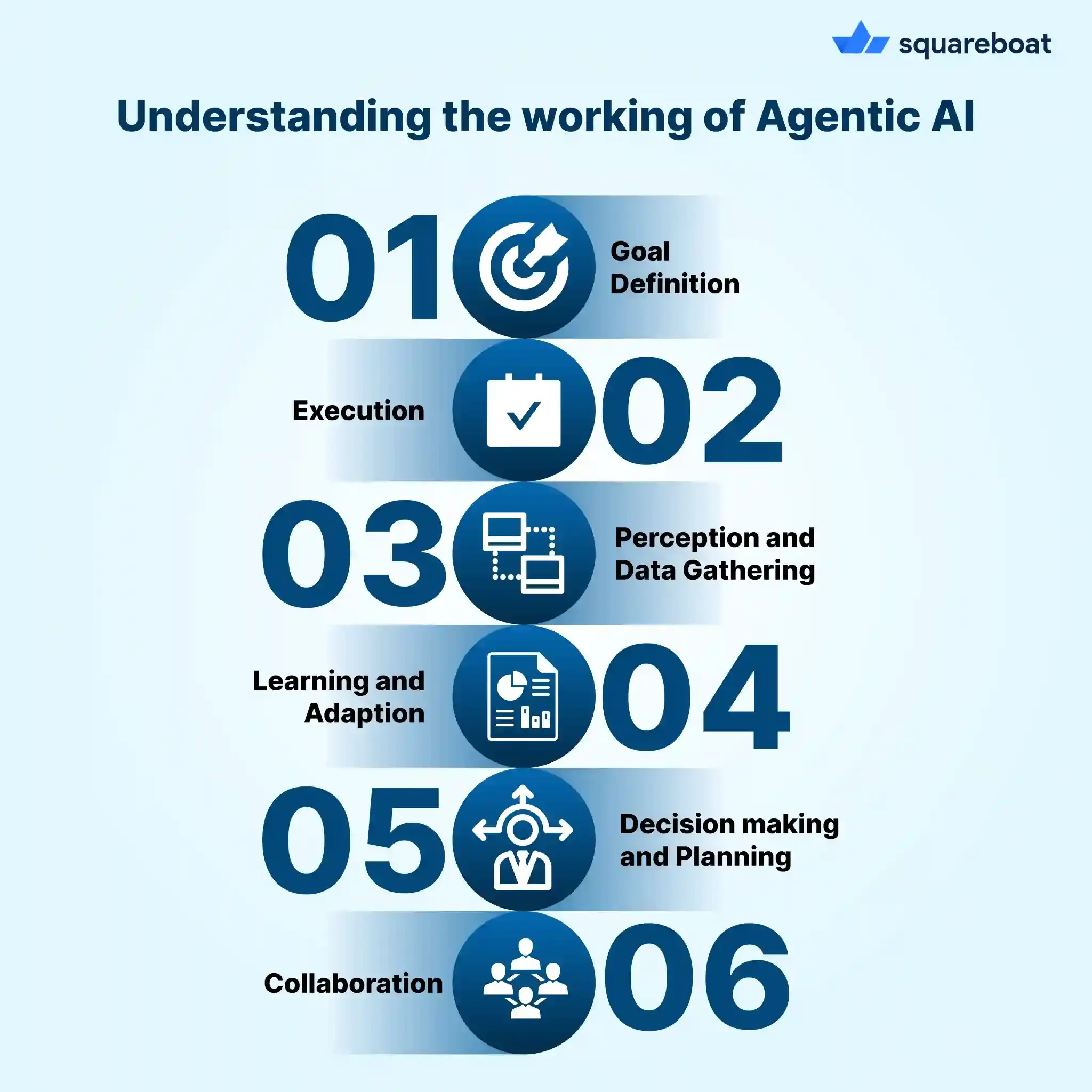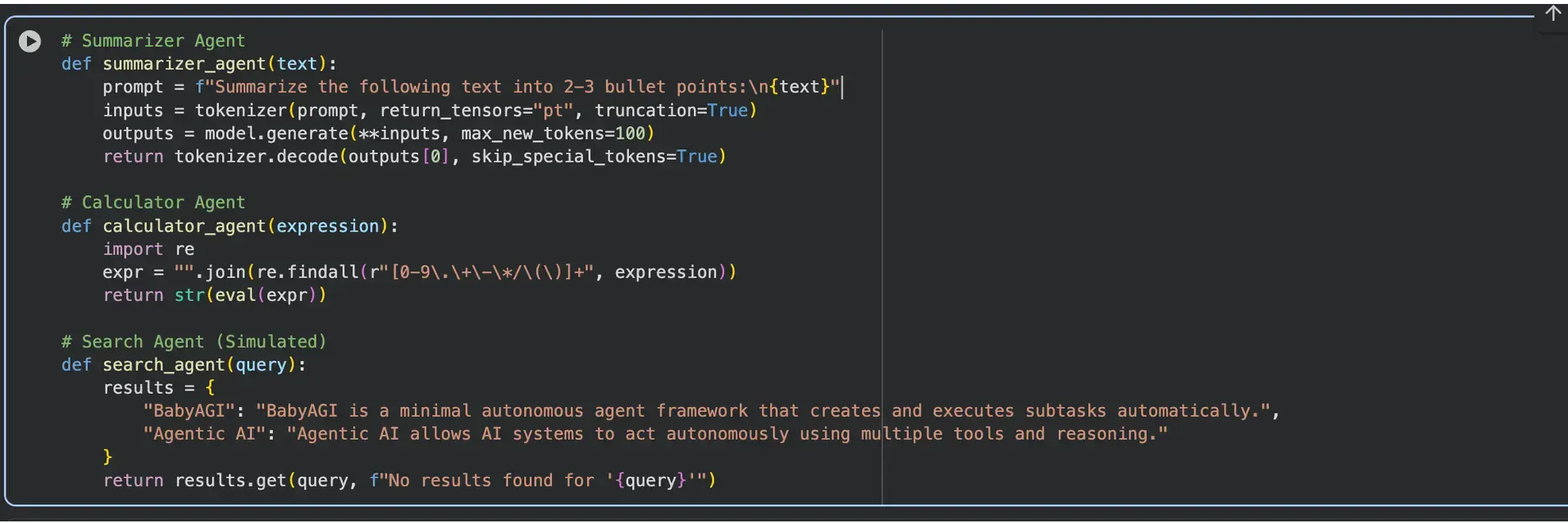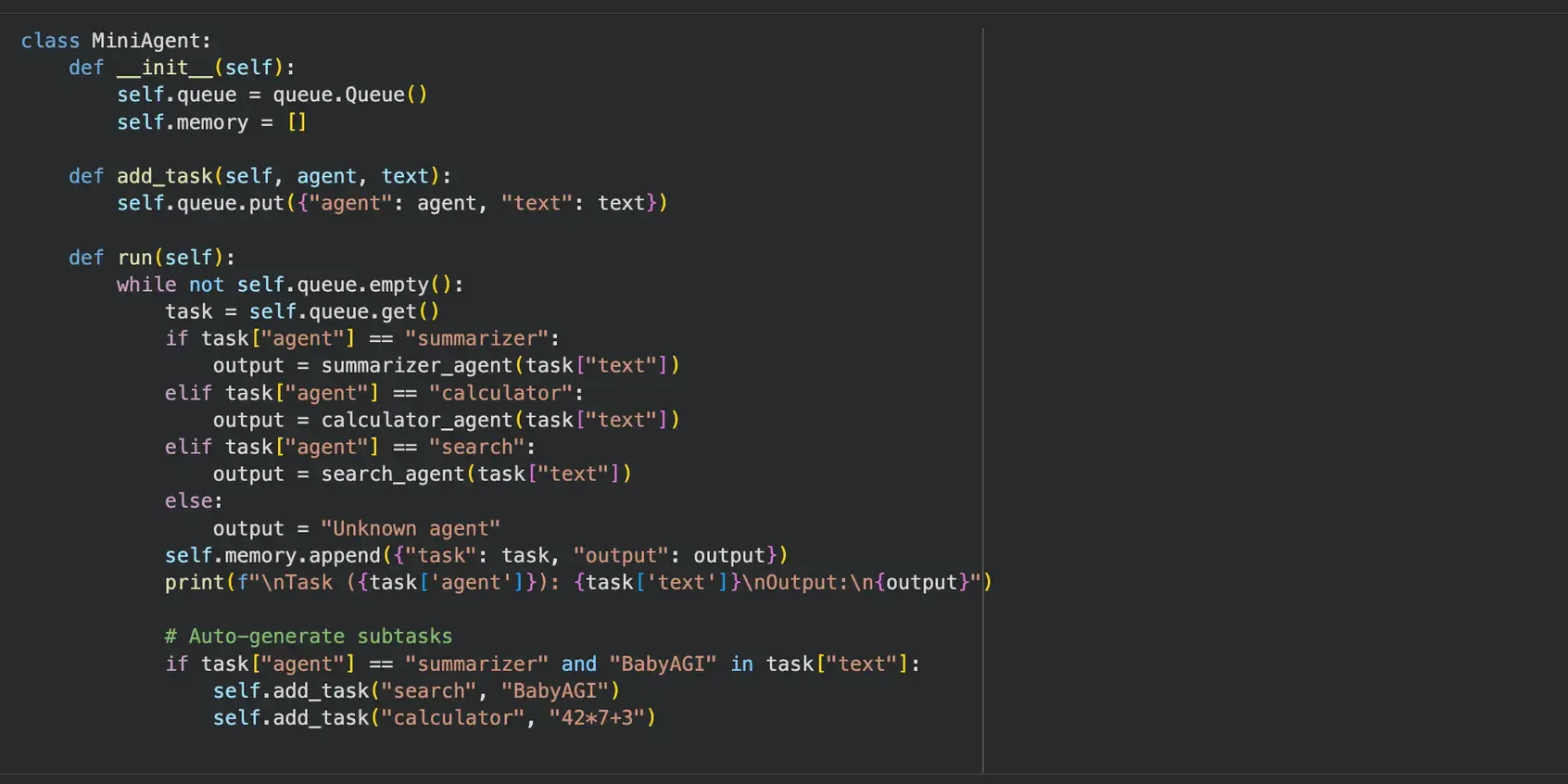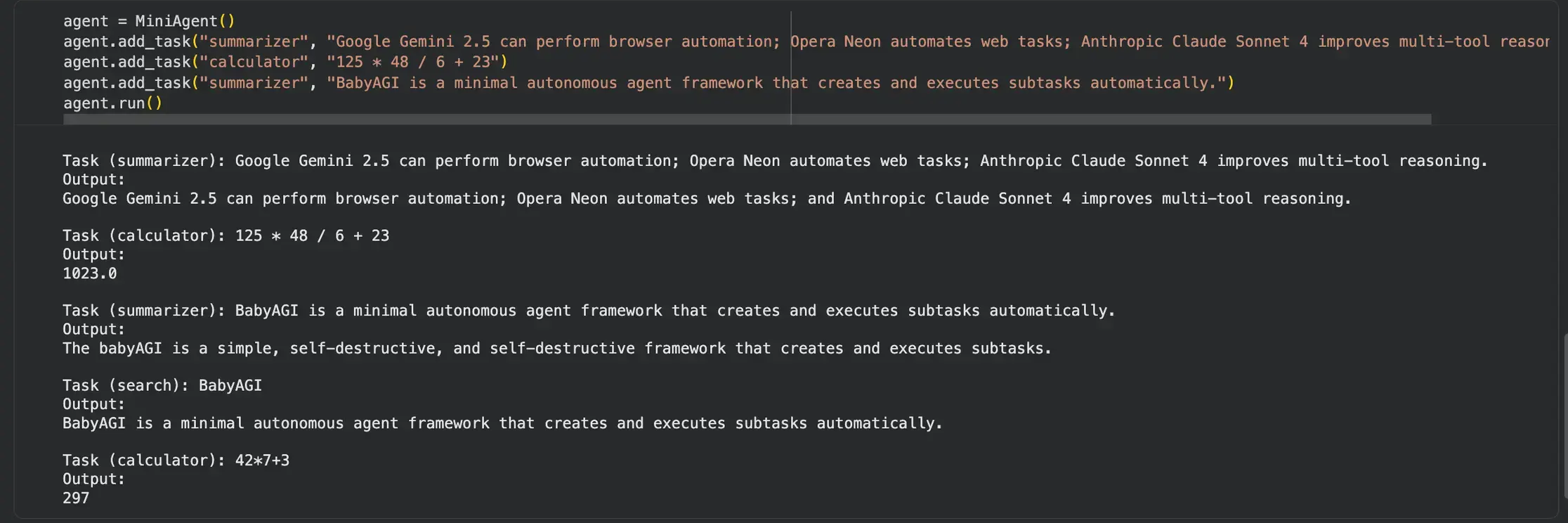AI is evolving from a reactive tool into an active collaborator, capable of thinking and acting on Artificial intelligence is moving beyond simple question-and-answer interactions. For years, AI worked like an advanced assistant: you give a command, it performs the task. Helpful, but passive. As businesses demand deeper automation, greater personalization, and systems that can manage complex workflows, a new generation of AI is emerging: Agentic AI. This shift increases the demand for skilled AI developers who can build systems capable of autonomous planning and execution.
Agentic AI represents systems that can set goals, plan their own actions, make decisions, and adapt as situations change. These systems don’t wait for the next user prompt. They work toward outcomes and actively adjust their strategies on the way. This shift is transforming how enterprises build and deploy intelligent solutions, bringing us closer to AI agents that operate with the independence of real team members.
What is Agentic AI?
Agentic AI refers to intelligent systems capable of operating independently and taking meaningful actions toward defined objectives. Instead of reacting to a single prompt or command, these systems:
- Understand a goal
- Collect relevant information
- Decide what needs to be done
- Execute tasks
- Learn from success and failure
Refine future behavior
Traditional AI and generative models are powerful but fundamentally dependent on user direction. They respond to input, produce outputs and wait for the next instruction. Agentic AI goes further by driving tasks on its own, making it valuable in dynamic, high-complexity environments such as enterprise automation, operations, logistics, and customer experience management.
Comparing Agentic AI, Generative AI, and Traditional AI
Feature | Agentic AI | Generative AI | Traditional AI |
Primary Function | Works independently to achieve goals | Creates content from prompts | Executes predefined rules |
Decision-Making | Chooses actions on its own | Responds only when prompted | No real decision-making |
Adaptability | Learns and improves from experience | Improves with training but still needs direction | Stays the same unless updated manually |
Human Intervention | Minimal supervision needed | Needs prompts for every task | Requires setup and ongoing updates |
Task Scope | Handles multi-step workflows | Good for single creative tasks | Best for simple and repetitive tasks |
Goal Orientation | Focuses on long-term outcomes | Produces one-off outputs | Executes tasks without a broader context |
Interaction Style | Proactive | Reactive | Static |
Memory & Learning | Can maintain memory for ongoing improvement | Limited session memory | No learning unless updated |
Collaboration | Can work with tools and other agents | Limited, depending on the platform | Works alone within defined rules |
Examples | Autonomous business agents | ChatGPT, Midjourney, Copilot | Rule-based fraud detection, macros |
How Agentic AI Works?

Agentic AI functions as an autonomous problem solver. Unlike traditional AI that waits for instructions or generative AI that produces outputs based on prompts, agentic AI is designed to take initiative, plan and act toward achieving defined goals. Here’s a breakdown of how it operates:
Goal Definition: The system is given a clear objective or set of objectives. These goals guide all decision-making and actions, giving the AI a sense of “purpose.”
Perception and Data Gathering: Agentic AI continuously monitors its environment, gathering data from internal systems, external APIs or user interactions. This information allows it to understand the current context and identify potential challenges or opportunities.
Decision-Making and Planning: Using reasoning and planning algorithms, the AI determines what actions are necessary to move closer to its goals. It can evaluate multiple strategies, predict outcomes and prioritize the most effective course of action.
Execution: The AI autonomously performs tasks, this can include generating content, interacting with other systems, executing workflows, or even coordinating with other agentic systems.
Learning and Adaptation: Agentic AI monitors the results of its actions and learns from successes and failures. This allows it to refine its strategies over time, adapt to changing conditions and improve performance without constant human intervention.
Collaboration: Agentic systems can work alongside other AI agents or humans in complex environments and coordinate efforts while sharing insights to achieve broader objectives.
In simple terms, Agentic AI behaves like a proactive colleague who identifies a problem, decides on a plan, executes it, and learns how to do it better the next time.
Architecture of AI Agents

AI agents, particularly agentic AI systems, are designed to operate autonomously, make decisions and achieve goals. Their architecture typically consists of several interconnected components that work together seamlessly:
- Perception Layer: This layer collects information from the environment (such as user inputs, APIs, sensors, databases, etc). It processes raw data into structured and understandable formats that the agent can act upon.
- Knowledge & Memory Module: Stores relevant information, past experiences and learned patterns. Provides context for decision-making so that the agent to learn from history and adapt strategies over time.
Reasoning & Planning Engine: Analyzes the current situation and predicts next actions using techniques such as:
- Reinforcement learning
- Symbolic reasoning
- Decision trees
- Planning algorithms- Action/Execution Layer: Implements the decisions made by the planning engine. Can interact with software systems, APIs, external agents, or generate outputs such as text, code, or reports.
- Learning & Adaptation Module: Monitors the outcomes of actions to assess effectiveness. Updates internal knowledge, adjusts strategies, and refines future decision-making. Enables continuous improvement and adaptation to dynamic environments.
- Communication & Collaboration Layer: Allows the agent to interact with humans or other AI agents.Facilitates multi-agent coordination for complex tasks.
The architecture of an AI agent is designed to mimic the flow of intelligent problem-solving:
perceive → reason → act → learn → adapt.
This modular approach allows agentic AI systems to operate autonomously, handle complexity, and evolve over time, which is why they are increasingly used in enterprise automation, autonomous workflows, and multi-agent systems.
Key Characteristics of AI Agents
Agentic AI systems are designed to operate intelligently. The following characteristics define what makes an AI system truly agentic:
1. Autonomy:
- Capable of performing tasks and making decisions without any continuous human guidance.
Can operate independently in dynamic complex environments.
2. Goal-Directed Behavior:
- Actions are guided by clearly defined objectives.
The agent focuses on achieving outcomes rather than just following instructions.
3. Adaptability:
- Learn from experiences and environmental changes.
Adjusts strategies and responses based on new information or unexpected situations.
4. Decision-Making Ability:
- Can evaluate multiple options, predict consequences and choose the most effective course of action.
- Incorporates reasoning and planning to solve problems autonomously.
5. Learning Capability:
- Continuously improves performance through feedback and data.
Can generalize knowledge to handle unseen scenarios effectively.
6. Proactivity:
- Anticipates potential issues or opportunities instead of merely reacting to prompts.
Take initiative to achieve objectives without waiting for instructions.
7. Collaboration and Communication:
- Can coordinate with other AI agents or humans to accomplish shared goals.
Exchanges information, negotiates tasks, integrates with larger systems, etc.
8. Persistence:
- Continues working toward goals even when facing obstacles or changing conditions.
- Maintains focus on long-term objectives rather than short-term tasks.
Types of AI Agents
AI agents are intelligent systems designed to perceive their environment, make decisions, take actions to achieve specific goals, etc. Based on their structure and operational setup, they can be broadly categorized into single agents and multi-agent systems. Each type has unique characteristics, strengths, and applications.
Single AI Agents
A single AI agent is an autonomous system that operates independently to accomplish a set of predefined or learned goals. It senses the environment and makes decisions based on its observations and internal reasoning. This thus executes actions to achieve its objectives.
Key Characteristics:
- Autonomous: Can operate without human intervention.
- Goal Oriented: Works toward a specific objective/objectives.
- Adaptive: Can learn from experience to improve performance over time.
Decision Making: Evaluates alternatives and chooses the most effective action.
Examples:
- Virtual Assistants: Siri or Google Assistant can independently manage tasks like setting reminders, sending messages, answering queries, etc.
- Autonomous Robots: Warehouse robots that navigate independently to move inventory items.
AI in Enterprise: AI systems that analyze financial transactions to detect fraud or optimize workflows.
Advantages:
- Simpler to design and implement.
- Highly focused on achieving specific tasks.
- Requires less coordination and communication.
Limitations:
- Limited in scope, can handle only tasks within its design parameters.
Cannot leverage collaboration for complex problem-solving.
Multiple AI Agents (Multi-Agent Systems)
A multi-agent system (MAS) consists of multiple AI agents that interact with each other in the same environment. These agents can collaborate, compete or even coexist, depending on the system design to achieve individual or shared goals. Key Characteristics:
- Collaboration: Agents can share information and coordinate actions.
- Competition: In some systems, agents may compete to achieve optimal outcomes.
- Communication: Requires protocols for exchanging information and negotiating tasks.
Distributed Intelligence: Tasks are divided among agents so that complex problems are handled easily.
Examples:
- Autonomous Vehicle Fleets: Self-driving cars coordinating traffic routes to reduce congestion.
- Supply Chain Management: Multiple AI agents managing inventory, logistics and demand forecasting across locations.
- Multi-Agent Simulations: Agents modeling economic markets, social behavior or environmental systems to study outcomes and optimize strategies.
Advantages:
- Can solve complex, distributed problems that single agents cannot handle.
- Flexible, i.e., agents can adapt individually or collectively to changing conditions.
- Robust, i.e., if one agent fails, others can continue functioning.
Limitations:
- More complex to design and manage.
- Requires sophisticated communication and coordination.
- Higher computational and operational overhead.

Use Cases of Agentic AI
Enterprise Automation
Agentic AI can manage end-to-end workflows that traditionally required multiple human teams.
Wipro & Google Cloud: Wipro has partnered with Google Cloud to deploy 200 AI agents across sectors like healthcare, banking, insurance, retail, manufacturing and IT. These agents aim to enhance efficiency, decision-making and user interactions.
OutSystems' Agent Workbench: OutSystems launched Agent Workbench, a platform enabling enterprises to develop and coordinate intelligent agents using a low-code approach. Early adopters like Thermo Fisher Scientific have used it to automate customer escalations.
Impact:
- Reduced manual effort
- Faster operations
Consistent decision-making across business functions
Customer Support and Experience
Salesforce Agentforce 360: Salesforce introduced Agentforce 360 integrating OpenAI's GPT-5 and Anthropic's Claude to enhance customer support. This platform allows users to build AI agents that can interact with customer data and analytics via tools like ChatGPT and Slack.
H&M's Virtual Shopping Assistant: H&M implemented a virtual agent capable of offering personalized product recommendations and guiding customers through the purchase process, leading to a 70% resolution rate for customer queries and a 25% increase in conversion rates.
Impact:
- Faster resolutions
- Improved satisfaction
- Lower support costs
Finance and Trading
Morgan Stanley & Bank of America: Both banks are utilizing generative AI to enhance internal operations. Morgan Stanley introduced tools like the Morgan Stanley Assistant and Debrief, powered by GPT-4, to help advisors retrieve insights and summarize client meetings.
Impact:
- Better financial decisions
- Reduced operational errors
Supply Chain and Logistics
Johnson & Johnson's AI Strategy: Johnson & Johnson shifted its AI strategy to focus on high-value applications. One such initiative is "Rep Copilot," an AI-driven tool assisting sales reps in engaging healthcare professionals, currently piloted in its Innovative Medicine division.
Impact:
- Increased efficiency
- Reduced costs
- Faster delivery times
Healthcare and Life Sciences
IBM Watson Agents: IBM's Watson agents offer business process management and compliance solutions for regulated industries such as healthcare and finance. These agents assist with tasks like medical coding and billing, improving operational efficiency.
Impact:
- Improved patient outcomes
- More proactive healthcare delivery
Latest Developments in Agentic AI
BabyAGI and Agent Frameworks
BabyAGI enables agents to set goals, break them into sub-tasks, plan and execute iteratively, with LLMs and memory modules guiding decisions.These frameworks allow building semi-agentic systems: agents that can autonomously perform multi-step tasks, call APIs, manage workflows and maintain context, though they still operate within defined boundaries rather than acting fully independently.
Google Gemini 2.5: Browser-Based Autonomous AI
Google’s Gemini 2.5 model can interact with web browsers like a human and performing tasks such as submitting forms and UI testing. This advancement enables autonomous web interactions especially for platforms lacking direct APIs.
Opera Neon: AI-Powered Web Automation
Opera has introduced Opera Neon, a browser that automates online tasks. It can conduct research, analyze multiple sources, and execute actions with minimal user input, leveraging reusable prompts and contextual understanding.
EU’s €1 Billion AI Initiative
The European Commission launched a €1 billion program, “Apply AI,” to promote agentic AI across industries like healthcare, energy, manufacturing and defense. This aims to reduce EU reliance on U.S. and Chinese AI technologies.
Amazon AWS and Agentic AI
Amazon’s AWS formed a dedicated group to develop agentic AI for automation. The initiative focuses on enabling AI systems, including Alexa to perform tasks independently without continuous user prompts.
Anthropic’s Claude Opus 4 and Sonnet 4
Anthropic released Claude Opus 4 and Claude Sonnet 4, enhancing agentic capabilities with parallel tool use, extended memory, improved coding, reasoning, and compliance with complex instructions.
How to Get Started with Agentic AI?
Agentic AI is still an emerging field, but you can begin exploring and leveraging it with the right tools, platforms, and learning approach. Here’s a step-by-step guide:
Understand the Basics
- Familiarize yourself with concepts like autonomy, goal-directed behavior, multi-agent systems, and reinforcement learning.
- Learn the differences between traditional AI, generative AI, and agentic AI to understand where agentic systems fit.
Explore Agentic AI Platforms
- Google Opal: Build AI mini-apps with no-code visual workflows. Great for prototyping and automation.
- Google Gemini 2.5 / Opera Neon: Experiment with AI agents that can autonomously interact with websites and workflows.
- Anthropic Claude 4: Access agentic features with enhanced reasoning, memory, and multi-tool usage.
Learn by Doing
- Start with small projects, such as building an autonomous workflow, a personal AI assistant, or a task-specific agent.
- Test multi-agent scenarios to understand collaboration and decision-making dynamics.
Use APIs and Integration Tools
- Many agentic AI platforms provide APIs or SDKs for integrating agents into apps, websites, or enterprise systems.
- Platforms like AWS, Azure, OpenAI, etc. allow developers to deploy autonomous AI agents in real-world environments.
Keep Ethics and Safety in Mind
- Design agents with clear goals and boundaries to ensure responsible use.
Monitor agent actions and incorporate human oversight, especially for high-stakes or sensitive applications.
Follow the Latest Developments
- Stay updated on new agentic AI releases, frameworks and research to make best use of the latest capabilities.
Join communities, forums, etc.
Hands-On Agentic AI: Mini-Agent Workflows
Agentic AI enables systems to autonomously perform tasks, coordinate multiple tools, and make goal-directed decisions. To illustrate this practically, we demonstrate agentic AI workflows. Agentic AI enables systems to autonomously perform tasks, coordinate multiple tools, and make goal-directed decisions. To illustrate this practically, we demonstrate two agentic AI workflows:
BabyAGI-Style Workflow
BabyAGI is designed to break down high-level goals into subtasks, execute them independently, and store the results in memory. It simulates a mini autonomous AI agent.
Step 1: Setup & Model Initialization

We use Flan-T5-small for summarization; lightweight for Colab. Queue is used to manage tasks autonomously.
Step 2: Define Agentic Tools

Summarizer condenses large texts into bullets.
Calculator evaluates arithmetic expressions autonomously.
Search simulates retrieving information; in real scenarios, it could call APIs.
Step 3: Task Manager (Mini BabyAGI)

The MiniAgent manages task queue and memory. Autonomous chaining: The agent can create new tasks based on the content of a task’s output. Memory stores all task results for later review or use in subsequent tasks.
Step 4: Run the Agent

The BabyAGI demo shows that even small-scale agentic AI agents can perform meaningful autonomous actions. It provides a concrete, hands-on introduction to concepts like goal decomposition, multi-step reasoning, and autonomous memory tracking, which are at the heart of modern agentic AI systems.
Final Thoughts
Agentic AI marks the shift from reactive machines to proactive and outcome-focused digital collaborators. Instead of simply answering questions or performing isolated tasks, agentic systems can:
- Understand goals
- Make decisions
- Execute steps independently
- Adapt and improve with time
- Work with humans or other agents
From enterprise operations to supply chains, healthcare, financial services, and customer support, agentic AI is already reshaping how large organizations work. As platforms such as Google Opal, Gemini, Opera Neon, Anthropic Claude, and AWS advance, access to real autonomous agents is becoming mainstream.
The potential is enormous, but responsible deployment matters. Human oversight, ethical boundaries, and transparency should remain central as autonomy increases.
For anyone willing to explore and experiment, we are at the beginning of a major technological shift, one where AI doesn’t just assist but collaborates, plans, and achieves results like a true digital teammate.

